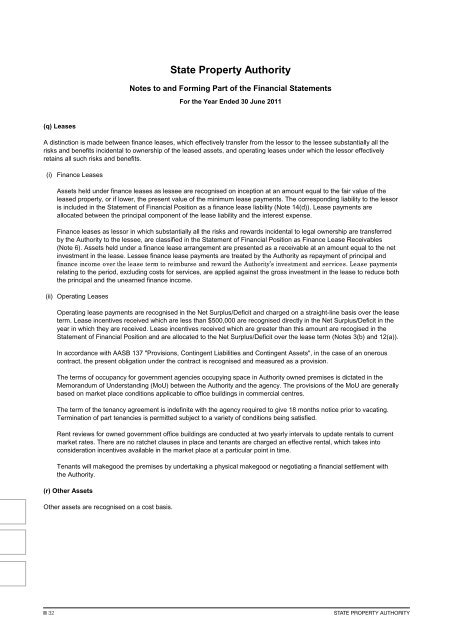Complete annual report 2010-11 - Land - NSW Government
Complete annual report 2010-11 - Land - NSW Government
Complete annual report 2010-11 - Land - NSW Government
You also want an ePaper? Increase the reach of your titles
YUMPU automatically turns print PDFs into web optimized ePapers that Google loves.
State Property Authority<br />
Notes to and Forming Part of the Financial Statements<br />
For the Year Ended 30 June 20<strong>11</strong><br />
(q) Leases<br />
A distinction is made between finance leases, which effectively transfer from the lessor to the lessee substantially all the<br />
risks and benefits incidental to ownership of the leased assets, and operating leases under which the lessor effectively<br />
retains all such risks and benefits.<br />
(i) Finance Leases<br />
Assets held under finance leases as lessee are recognised on inception at an amount equal to the fair value of the<br />
leased property, or if lower, the present value of the minimum lease payments. The corresponding liability to the lessor<br />
is included in the Statement of Financial Position as a finance lease liability (Note 14(d)). Lease payments are<br />
allocated between the principal component of the lease liability and the interest expense.<br />
Finance leases as lessor in which substantially all the risks and rewards incidental to legal ownership are transferred<br />
by the Authority to the lessee, are classified in the Statement of Financial Position as Finance Lease Receivables<br />
(Note 6). Assets held under a finance lease arrangement are presented as a receivable at an amount equal to the net<br />
investment in the lease. Lessee finance lease payments are treated by the Authority as repayment of principal and<br />
finance income over the lease term to reimburse and reward the Authority’s investment and services. Lease payments<br />
relating to the period, excluding costs for services, are applied against the gross investment in the lease to reduce both<br />
the principal and the unearned finance income.<br />
(ii) Operating Leases<br />
Operating lease payments are recognised in the Net Surplus/Deficit and charged on a straight-line basis over the lease<br />
term. Lease incentives received which are less than $500,000 are recognised directly in the Net Surplus/Deficit in the<br />
year in which they are received. Lease incentives received which are greater than this amount are recogised in the<br />
Statement of Financial Position and are allocated to the Net Surplus/Deficit over the lease term (Notes 3(b) and 12(a)).<br />
In accordance with AASB 137 "Provisions, Contingent Liabilities and Contingent Assets", in the case of an onerous<br />
contract, the present obligation under the contract is recognised and measured as a provision.<br />
The terms of occupancy for government agencies occupying space in Authority owned premises is dictated in the<br />
Memorandum of Understanding (MoU) between the Authority and the agency. The provisions of the MoU are generally<br />
based on market place conditions applicable to office buildings in commercial centres.<br />
The term of the tenancy agreement is indefinite with the agency required to give 18 months notice prior to vacating.<br />
Termination of part tenancies is permitted subject to a variety of conditions being satisfied.<br />
Rent reviews for owned government office buildings are conducted at two yearly intervals to update rentals to current<br />
market rates. There are no ratchet clauses in place and tenants are charged an effective rental, which takes into<br />
consideration incentives available in the market place at a particular point in time.<br />
Tenants will makegood the premises by undertaking a physical makegood or negotiating a financial settlement with<br />
the Authority.<br />
(r) Other Assets<br />
Other assets are recognised on a cost basis.<br />
32<br />
State Property Authority

















